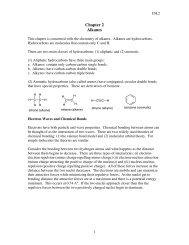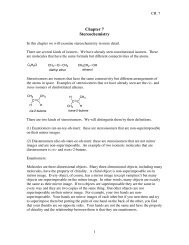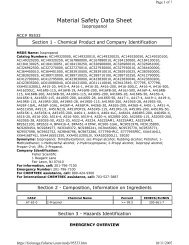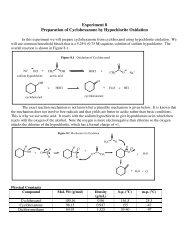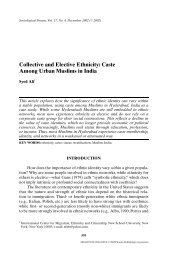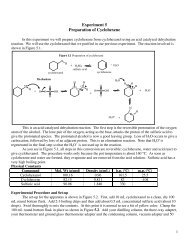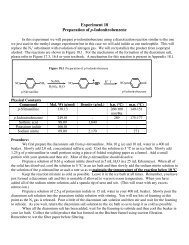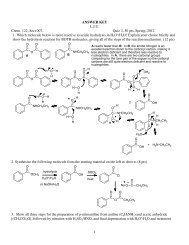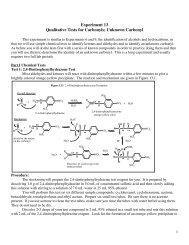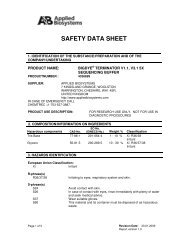Aldehydes and Ketones - myweb
Aldehydes and Ketones - myweb
Aldehydes and Ketones - myweb
You also want an ePaper? Increase the reach of your titles
YUMPU automatically turns print PDFs into web optimized ePapers that Google loves.
<strong>Aldehydes</strong> <strong>and</strong> <strong>Ketones</strong><br />
Experiment #4<br />
Objective: To study some chemical reactions that are used to distinguish aldehydes <strong>and</strong> ketones,<br />
especially oxidation of aldehydes.<br />
Introduction<br />
<strong>Aldehydes</strong> <strong>and</strong> ketones both contain the carbonyl functional group, which imparts similar<br />
chemical reactivities to these two classes of compounds with some reagents. <strong>Aldehydes</strong> are<br />
much more susceptible to oxidation because a hydrogen atom is attached to the carbonyl, which<br />
is the basis for some of the chemical reactions that distinguish between these two classes of<br />
compounds.<br />
The oxidation of aldehydes can be performed with a mild oxidizing agent, such as Ag + in<br />
ammonia solution used in the Tollens test or Cu 2+ in alkaline solution used in Fehling's test. If<br />
the Tollens test is performed in a scrupulously clean glass vessel, the silver metal is plated on the<br />
walls of the glass to form a silver mirror; contaminants may result in the reduced silver forming a<br />
gray sludge in the bottom of the tube. Fehling's reagent is a deep blue Cu 2+ solution that forms a<br />
brick-red precipitate of Cu 2 O in the presence of aldehydes.<br />
A stronger oxidant such as chromic acid, which was used to oxidize alcohols in the<br />
previous experiment, will also oxidize aldehydes readily, but generally does not oxidize ketones.<br />
The chromic acid in Bordwell-Wellman reagent is an orange-yellow solution that forms the green<br />
Cr 3+ ion when it is reduced by alcohols or aldehydes. <strong>Ketones</strong> should give no reaction.<br />
27
Methyl ketones react with iodine (I 2 ) in the presence of strong base to form iodoform, a<br />
yellow compound insoluble in water. The reaction is summarized below. The resulting<br />
iodoform has an odor similar to chloroform <strong>and</strong> can be used as a topical disinfectant usually in<br />
veterinary medicine.<br />
Materials <strong>and</strong> Reagents<br />
Test tubes, 6 M sodium hydroxide, 6 M ammonium hydroxide, dilute nitric acid,<br />
Fehling's solutions A <strong>and</strong> B, Bordwell-Wellman reagent, iodine in potassium iodide solution,<br />
acetone, benzaldehyde, acetaldehyde, cyclohexanone, 2-pentanone, 3-pentanone, <strong>and</strong> unknowns.<br />
Procedure<br />
Begin Here: Fill a 250 mL beaker about half full with water <strong>and</strong> heat it on a hot plate for Part B.<br />
Part A. Tollens' Silver Mirror Test (Start this after setting up hot water bath)<br />
Note: Test tubes must be scrupulously clean for the silver mirror test to work. Be sure to rinse<br />
tubes well with deionized water. The chloride ions in tap water interfere with mirror formation.<br />
1. Wash 5(or 6 if working in pairs) test tubes thoroughly with soap/detergent <strong>and</strong> water <strong>and</strong><br />
rinse well. Give at least 2 final rinses with deionized water.<br />
2. Add 10 drops of 6 M NaOH to each test tube <strong>and</strong> swirl the tube. Allow the NaOH<br />
solution to remain in the tube for about 1 min, then discard the NaOH solution in the<br />
sink. DO NOT RINSE THE TEST TUBES!!!<br />
3. Add about 1 mL of 0.1 M silver nitrate solution to each test tube. A brown precipitate of<br />
silver hydroxide (AgOH) may form.<br />
4. Add a few (2 to 4) drops of 6 M ammonium hydroxide (NH 4 OH) solution to get the<br />
brown precipitate to dissolve. Shake to completely dissolve the brown precipitate. Add a<br />
few more drops of NH 4 OH solution, if needed, until the precipitate completely dissolves.<br />
5. Add 3 drops of acetone to tube 1; 3 drops of benzaldehyde to tube 2; 3 drops<br />
acetaldehyde solution to tube 3; 3 drops cyclohexanone to tube 4 <strong>and</strong> 3 drops of unknown<br />
to tube 5.<br />
6. Mix each well <strong>and</strong> allow to st<strong>and</strong> without further shaking for 5 to 10 min <strong>and</strong> look for the<br />
formation of mirrored glass on the walls of the test tube (or gray sludge in the bottom).<br />
7. Record your observations on the Report Sheet, Table 1.<br />
28
8. Dispose of these reagents in the "Liquid Waste" container in the hood.<br />
9. Add dilute nitric acid (HNO 3 ) to the mirrored glass tubes to remove the silver deposits.<br />
Dispose of the nitric acid in the sink <strong>and</strong> flush with plenty of water.<br />
Part B. Fehling's Test<br />
The water bath you set up earlier should be boiling. Set the hot plate temperature control to a<br />
medium setting. Use 5 clean test tubes if working alone, or 6 test tubes if working in pairs.<br />
1. Add 5 (or 6) mL of Fehling's Solution A to a small beaker <strong>and</strong> mix 5 (or 6) mL of<br />
Fehling's Solution B with it. Notice the change in color of the Cu 2+ ion when these<br />
solutions are mixed.<br />
2. Add about 2 mL of the mixture prepared in step 1 to each of 5 (or 6) clean test tubes.<br />
3. Add 5 drops of the following test compounds (aldehydes/ketones) to the Fehling's reagent<br />
in each test tube. Acetone in tube 1; benzaldehyde in tube 2; acetaldehyde in tube 3;<br />
cyclohexanone in tube 4; <strong>and</strong> unknown in tube 5 (<strong>and</strong> 6).<br />
4. Make sure the tubes are properly labeled before placing them in the boiling water bath.<br />
5. After heating the mixtures for 5 minutes, take note of any changes in color or formation<br />
of a precipitate.<br />
6. Record your observations on the Report Sheet, Table 1.<br />
7. Turn off the hot plate, the water bath is no longer needed.<br />
Dispose of these reagents in the "Liquid Waste" container in the hood.<br />
Part C. Oxidation with Chromic Acid<br />
CAUTION!! Concentrated sulfuric acid in the Bordwell-Wellman reagent is very<br />
corrosive. H<strong>and</strong>le it with care in the hood.<br />
1. Add 6 to 8 drops of each of the following test compounds (aldehydes/ketones) to 5 (or 6<br />
if working in pairs) clean test tubes: acetone in tube 1; benzaldehyde in tube 2;<br />
acetaldehyde in tube 3; cyclohexanone in tube 4; <strong>and</strong> unknown(s) in tube(s) 5 (<strong>and</strong> 6).<br />
2. Add 1 or 2 drops of Bordwell-Wellman reagent solution to each of the test tubes<br />
containing the test aldehydes or ketones.<br />
3. Mix well <strong>and</strong> note any color changes after a few minutes. If there is a reaction, the color<br />
should change from yellow/orange to green or brown.<br />
29
4. Record your observations on the Report Sheet, Table 1.<br />
Dispose of these reagents in the "Liquid Waste" container in the hood.<br />
Part D. The Iodoform Reaction<br />
1. Add 1 mL of 6 M sodium hydroxide (NaOH) solution to each of 5 (or 6) clean test tubes.<br />
2. Add 5 drops of the following test compounds to these tubes, one at a time. Acetone in<br />
tube 1; 2-pentanone in tube 2; 3-pentanone in tube 3; cyclohexanone in tube 4; <strong>and</strong><br />
unknown in tube 5 (<strong>and</strong> 6 if working in pairs).<br />
3. Add 2 drops of iodine (I 2 /KI) solution to each test tube <strong>and</strong> observe whether there is a<br />
yellow precipitate or cloudiness of iodoform in each tube. If you see a red ring floating on<br />
top of a relatively clear solution, the iodine probably did not react.<br />
4. Record your observations on the Report Sheet, Table 1.<br />
Dispose of these reagents in the "Halogenated Organic Liquid Waste" container in the<br />
hood.<br />
30
Name ____________________________________<br />
<strong>Aldehydes</strong> <strong>and</strong> <strong>Ketones</strong><br />
Experiment #4<br />
Section ________________<br />
Pre-Lab Exercise<br />
1. Describe the difference between an aldehyde <strong>and</strong> a ketone, <strong>and</strong> indicate how each differs from an<br />
alcohol.<br />
2. Name one aldehyde or ketone that is used widely by consumers. Be sure to give the correct name<br />
<strong>and</strong> indicate its use.<br />
3. Describe what is meant by oxidation <strong>and</strong> reduction in relation to organic compounds, giving one<br />
example of oxidation of an organic compound <strong>and</strong> one example of reduction of an organic<br />
compound. The compound you use for the example may be the same or different for the<br />
oxidation <strong>and</strong> the reduction reactions. Be sure to indicate what oxidizing agent is used <strong>and</strong> what<br />
reducing agent is used for each example.<br />
31
4. A screening test is common to test for phenylketonuria (PKU) measures phenylalanine or<br />
phenylpyruvate in the urine. Show the structures of phenylalanine <strong>and</strong> phenylpyruvate<br />
<strong>and</strong> indicate whether any of the tests described in this experiment would give positive<br />
results with either of these urinary metabolites. Is phenylpyruvate a ketone? Is it a methyl<br />
ketone? See your text for discussion of this genetic disorder.<br />
5. Give a brief description of some of the health effects that phenylketonuria (PKU) can<br />
have on new born children <strong>and</strong> what precautions must be taken to prevent these unwanted<br />
health effects. (See your text or internet sources).<br />
32
Name _______________________________________<br />
Section ________<br />
<strong>Aldehydes</strong> <strong>and</strong> <strong>Ketones</strong><br />
Experiment #4<br />
Data & Report Sheet<br />
Table 1. Tests for <strong>Aldehydes</strong> <strong>and</strong> <strong>Ketones</strong>. [indicate whether you observed a positive reaction<br />
(+) or no reaction (-), in each test <strong>and</strong> note any color changes or other changes4].<br />
Unknown # _______<br />
Tollens<br />
Test<br />
Fehling's<br />
Test<br />
Chromic Acid<br />
Test<br />
Iodoform<br />
Test<br />
Acetone<br />
Benzaldehyde<br />
_______<br />
Acetaldehyde<br />
_______<br />
Cyclohexanone<br />
2-Pentanone _______ _______ _______<br />
3-Pentanone _______ _______ _______<br />
Unknown # _______<br />
Questions<br />
1. After looking at the results in Table 1, to what class of compound would you conclude<br />
your unknown belongs? (Aldehyde, ketone, methyl ketone, aromatic aldehyde)<br />
33
2. Which one of the tests performed in this experiment would be most useful in<br />
differentiating butanal <strong>and</strong> benzaldehyde. Which of the test compounds (acetone,<br />
acetaldehyde, benzaldehyde or cyclohexanone) should react in the same way as butanal in<br />
these tests? Explain your answer.<br />
3. Did any of the first three reagents (Tollens, Fehling's or chromic acid) react differently<br />
with benzaldehyde than it did with other aldehydes?<br />
34



